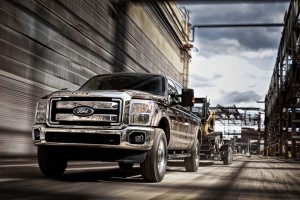Some of the industry’s biggest automakers have decided to go tow-to-tow. Few pieces of data in the car and truck business provoke as many claims and counter-claims as towing capacity, which can be even more important than raw horsepower in some segments.
Indeed, earlier this year, the nation’s two largest automakers went back-and-forth as they repeatedly raised their numbers, Ford ultimately asserting king-of-the-hill status for its big F-350s and F-450s, claiming 17,500 pounds of capacity on some models, 1,000 more than the top-rated Chevrolet — which prompted its Detroit rival to cry foul and many potential customers to ask who is really on top.
But there should be no debate who really is the tow-master, reports our friend and colleague Mark Phelan, of the Detroit Free Press, thanks to an agreement between the leading full-size truck producers to accept a new Society of Automotive Engineers standard that should set uniform testing procedures.
It’s one of those ideas whose time had come, especially as the truck market has shifted quite a bit in recent years.
“The personal-use buyer, who just liked owning a large truck is largely gone,” notes Larry Dominique, the Nissan executive who oversaw development of the maker’s Titan truck. But demand is still strong, despite $4 gas, he adds, accounting for more than 11% of the total U.S. new vehicle market. And, now focused on buyers who really need full-sized pickups for work or to actually tow things like RVs and horse trailers, a legitimate towing standard is needed more than ever.
Imagine, notes Phelan, if every maker got to set its own fuel economy ratings, rather than using the standardized EPA test cycle. Or range numbers for battery-electric vehicles. Early figures for vehicles like the Nissan Leaf and Chevrolet Volt all tumbled once they were put through the uniform EPA test.
“Before, you couldn’t say who had the best towing capacity, because you didn’t know how it was tested,” said Mike Levine, editor of Pickuptrucks.com, and a regular contributor to TheDetroitBureau.com. “This is the first time a customer can do an actual apples-to-apples comparison.”
Ironically, the new rules involve the sort of grueling torture tests manufacturers already use while developing their biggest trucks, like running them up steep inclines and pulling maximum loads in hot temperature while ensuring transmissions and brakes can hold up.
Detroit’s Big Three will adopt the new test procedures next January, and Nissan says it will eventually come onboard, as well, which only leaves Toyota which, like its Japanese rival, has struggled to gain some traction in the full-size pickup segment, the last dominated by the Motor City.
The procedure will be voluntary, unlike the current federal mileage standards which must be government certified – the results placed on that familiar Munroney window sticker – before a vehicle can even go on sale.
But earning the SAE’s equivalent of the Good Housekeeping Seal could become just as critical to skeptical, picky buyers who want to know that the latest king-of-the-hill really can haul its load.

